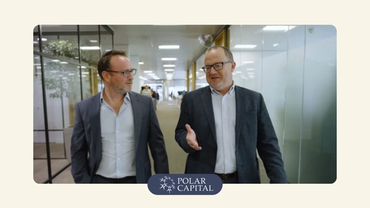Home • Articles • Investing for income: How the Scottish American Investment Company puts ‘tortoise vs hare’ to the test
Investing for income: How the Scottish American Investment Company puts ‘tortoise vs hare’ to the test
By Boring Money
13 Nov, 2024
This content is a paid promotion and has been created in collaboration with Baillie Gifford. It is an advertorial designed to promote the Scottish American Investment Company (SAINTS). While we strive to ensure the information provided is accurate and relevant, it reflects the views and messaging of the sponsor.
While the long-term growth of an investment portfolio is often the primary goal, there are plenty of circumstances where you might appreciate a regular stream of income from your investments too. We spoke to the fund managers at the Scottish American Investment Company (SAINTS) about how they invest for long-term growth while also prioritising income for shareholders.

As with any investment, capital is at risk and income is not guaranteed. This is a paid promotion with Baillie Gifford.
Introduction to income investing and SAINTS
Income investing is the practice of investing in assets which aim to deliver a regular income, typically in the form of dividend payments, which effectively act as a “reward” for investing in your chosen investments. These can be received on any regular basis – monthly, quarterly, biannually or annually are the most common intervals.
Selecting investments which you can depend on to deliver income is not always easy though – after all, when it comes to investing, nothing is guaranteed, so how do you know which ones you can rely on?
The Scottish American Investment Company P.L.C. (SAINTS), managed by investment manager Baillie Gifford, is designed with income in mind – it aims to be a “core” investment for investors seeking income and capital growth over the long term.
Most importantly, it focuses on dividend growth, not dividend yield. SAINTS aims for that income growth to outpace inflation, to ensure investors are protected from the eroding effect of inflation.
SAINTS has been operating since 1873 and deals out dividends on a quarterly basis. At the time of writing, its dividend yield is 2.83% and it boasts a 5-year dividend growth rate of 4.16% pa. The portfolio is primarily invested in global equities but also includes a blend of bonds, property and cash equivalents.[1]
The philosophy behind investing for income
At the time of its inception in Victorian Edinburgh, private investors seeking reliable and rewarding returns had few choices – dependable but disappointing government-backed “consols” or high-risk equities such as US railroad stocks.
Edinburgh-based SAINTS was one of the first viable alternatives, offering ordinary investors “the quadruple benefits of portfolio diversification, professional management, an attractive income and a protective structure” all in one.
SAINTS prided itself on being “prepared to fight for investors’ interests - a principle that has stuck fast for 150 years”. Indeed, in its 2024 half-year results, SAINTS stated that “perseverance remains the name of the game”, ever more so in the face of uncertainty in global equity markets.[2]
One of its cornerstone philosophies relates to Aesop’s tortoise and hare story: “In Aesop's well-known fable about the hare and the tortoise, the hare bounds ahead after the gun fires, until, over-confident of victory in a long race, he decides to take a nap. The tortoise meanwhile perseveres at a steady pace, ever-onwards, eventually over-taking the hare and crossing the finish line in first place”.
In other words, SAINTS revolves around steady growth and the principle of compound interest –the practice of earning interest on an investment and reinvesting that income to earn interest on a now-larger base. Repeating that pattern over long periods can have a very large impact, and compounding is sometimes referred to as the “snowball effect”.
One of the biggest proponents of compounding is famed investor Warren Buffet, among the most renowned investors of all time. He favours a longer-term approach to investing, even going as far as to say: “If you aren't thinking about owning a stock for 10 years, don't even think about owning it for 10 minutes”.[3]
“Long-time shareholders will know that SAINTS is focused on the steady long-term compounding of earnings and dividends,” the managers at SAINTS explain. “We self-identify as tortoises. We invest in companies which we expect to grow their earnings on average around 10% per annum, faster than the long-term market average of around 5%; indeed actually quite fast for a tortoise!”[4]
How SAINTS selects companies with growth potential
James Dow, lead-manager of the trust, says: “The Scottish American Investment Company (SAINTS) is also a big believer in the value of compounding. Our job is to keep getting better at spotting the companies that can deliver it.”[5]
Doing so is not always easy though – after all, it requires an element of future prediction! Companies with the potential to compound their earnings at 10% or more for a decade-plus are rare. A 2016 study by Michael Mauboussin, a finance professor at Columbia University, found that only one in five of the 37,000 stocks he surveyed steadily compounded their earnings at 10 per cent a year or better.[6]
Two examples of companies SAINTS invested in with the belief they would deliver consistent returns for investors are Watsco and Microsoft. Watsco, a Miami-based air-conditioning unit distributor, was initially a small player but had the potential to grow into the $17bn air conditioning market in the US.
Dow says: “It wasn’t ‘capital intensive’ – it didn’t need much extra investment to grow further – and could therefore pay out profits in dividends more generously than its peers”.[7]
Indeed, Watsco would go on to grow its profits at a compound annual rate of 16% and has never made a loss. Dow says: “It’s easy to see it enjoying another decade of 10 per cent compound annual growth in a market that’s set to grow by 6 per cent a year until 2030”.[8]
Another example of SAINTS’ successful selection process is Microsoft. Even after decades of strong growth, the software and Cloud computing market is sufficiently large – and seemingly ever-expanding! – that there is still room for Microsoft to keep adding functionalities and services, with AI the next exciting leg of that journey. That is to say, there is no ceiling in sight just yet. “We think it can deliver 10 per cent growth for at least another decade”, adds Dow.[9]
Not every stock in the SAINTS portfolio will grow at this rate. But if the managers can pick a few consistent compounders, this should continue to drive returns for shareholders.
Other examples of companies in SAINTS’ portfolio which have delivered consistent 10%+ per year earnings growth for a decade or more include: Deutsche Boerse (Germany, stock exchange); Procter and Gamble (USA, consumer products); and Intuit (USA, software).
None of these businesses, Dow explains, are growing at a spectacular rate. Not like Nvidia, the tech titan which has boasted returns of almost 2,500% since October 2019. However, as awe-inspiring as those figures seem, the team at SAINTS believe this level of rapid growth is unsustainable.
“Nvidia, it must be said, is a fascinating conundrum. Without a doubt, it’s a special company, with a visionary leader, and a probably-enduring lead in designing AI chips. But the challenge with investing in Nvidia is that in some ways it is reminiscent of Cisco, or Nortel Networks, in the heady days of the early internet”.[10]
In other words, Nvidia’s eye-watering ascent has pushed it into so-called “bubble territory”, where its share price has so far exceeded its fundamental value it becomes an inevitability that it will correct itself – the fear being it could do so very sharply.
Instead, SAINTS focuses on stocks that cultivate outperformance over longer periods of time, based on “relentless high-single-digit to low-double-digit compounding of earnings and dividends”.[11]
What’s more, these types of stocks are often underpriced thanks to the chronic “short-termism” of much of the market – where moderate earnings potential over longer periods (e.g. Intuit) is often overlooked in the interest of higher short-term returns (e.g. Nvidia).
Overall, SAINTS maintains that companies that commit to paying growing dividends “often have what it takes to keep on compounding at 10 per cent or more”. This is based on a number of strong foundations: typically including “a proven business model, strong defenses against competitors, steady earnings and cashflow, resilience, good habits of reinvestment and the kind of growth that generates lots of spare cash”.[12]
These companies can often be hidden or underappreciated gems, and this is reflected in the fact that SAINTS often trades at a discount to the net asset value per share – at the time of writing, it is over a compelling –8%.[13]
In short, SAINTS is a well-diversified portfolio of quality, resilient businesses which are expected to compound earnings and dividends over the long term. This approach is why it has been an all-weather investment trust with an impressive track record of 50 years of dividend growth.
Definitions:
Dividend yield: Shows how much a company pays out in dividends each year relative to its stock price.
Cash equivalents: The value of a company's assets that are cash or can be converted into cash immediately.
Annual past performance to 30 September each year (net %)
| 2020 | 2021 | 2022 | 2023 | 2024 |
The Scottish American Investment Company P.L.C. (SAINTS) | 8.7 | 16.3 | -7.2 | 12.8 | 6.5 |
NAV* | 7.9 | 19.7 | 4.5 | 7.3 | 11.4 |
FTSE All-World Index | 5.7 | 22.7 | -3.6 | 11.1 | 20.2 |
Source: Morningstar, share price, total return.
Annual SAINTS dividends to 30 June each year
Year to June | 2020 | 2021 | 2022 | 2023 | 2024 |
Dividend Per Share (p) | 12.00 | 12.125 | 13.20 | 13.92 | 14.35 |
Year on Year Change (%) | 2.6 | 1.0 | 8.9 | 5.5 | 3.1 |
Source: Baillie Gifford & Co. Total dividend per ordinary share. Pence per share.
Past performance is not a guide to future returns.
Important Information
Investments with exposure to overseas securities can be affected by changing stock market conditions and currency exchange rates.
The views expressed in this article should not be considered as advice or a recommendation to buy, sell or hold a particular investment. The article contains information and opinion on investments that does not constitute independent investment research, and is therefore not subject to the protections afforded to independent research.
Some of the views expressed are not necessarily those of Baillie Gifford. Investment markets and conditions can change rapidly, therefore the views expressed should not be taken as statements of fact nor should reliance be placed on them when making investment decisions.
Baillie Gifford & Co Limited is wholly owned by Baillie Gifford & Co. Both companies are authorised and regulated by the Financial Conduct Authority and are based at: Calton Square, 1 Greenside Row, Edinburgh EH1 3AN.
The investment trusts managed by Baillie Gifford & Co Limited are listed on the London Stock Exchange and are not authorised or regulated by the Financial Conduct Authority.
A Key Information Document is available by visiting bailliegifford.com
---
[1] The Association of Investment Companies, November 2024
[2] Scottish American Investment Co PLC, July 2024
[3] Warren Buffet, February 1997
[4] Scottish American Investment Co PLC, July 2024
[5] Baillie Gifford, September 2022
[6] Baillie Gifford, September 2022
[7] Baillie Gifford, September 2022
[8] Baillie Gifford, September 2022
[9] Baillie Gifford, September 2022
[10] Scottish American Investment Co PLC, July 2024
[11] Baillie Gifford, September 2022






